Ever seen someone drop a ^^ in a text or comment and wondered, “Wait… what does that mean?” You’re not alone! This double caret symbol is popping up everywhere—from Snapchat streaks to TikTok captions to casual DMs. While it might look like just a pair of arrows or eyes, it actually carries some super specific vibes.
Depending on context, ^^ can signal happiness, agreement, or even cuteness—kind of like a textual smile or a shy giggle. It’s one of those lowkey emojis Gen Z and K-pop fans use to soften a convo or respond sweetly without saying too much.
In this guide, we’re breaking down exactly what ^^ means in chats and posts, where it came from, and how to use it without sounding clueless. Let’s decode the symbol that’s quietly taking over your inbox 📲
Definitions & Meaning
The symbol “^^” in text is primarily used to represent a smiling or happy face. Visually, it resembles two upward-turned eyes, mimicking the expression of joy or contentment. This simple emoticon conveys positivity, friendliness, or approval without needing to write out words like “smile” or “happy.”
Unlike emoji, which are graphic and standardized across platforms, “^^” is a text-based emoticon that relies on imagination. When someone types “^^” after a message, it often suggests they are pleased, amused, or expressing lightheartedness. For example, if a friend says, “I finished the project early,” replying with “^^” signals encouragement or happiness for their success.
The symbol can also imply a playful tone or a subtle way of softening a statement, making the interaction feel more casual and warm. Its simplicity and ease of use have contributed to its steady presence in informal digital conversations.
Origins & History
The use of “^^” as a textual expression traces back to early internet culture, particularly within Asian online communities such as Japanese and Korean forums and chatrooms. In these cultures, emoticons and kaomoji (Japanese emoticons) have long been a creative way to add emotional layers to text.
“^^” is thought to have evolved from these kaomoji traditions, where characters like “^^” or “(^^)” were used to depict smiling faces with eyes closed or squinting in happiness. Over time, the simpler “^^” became a shorthand version, easier to type and widely adopted beyond its original cultural roots.
As internet users from different countries interacted, this symbol spread into Western social media platforms and texting apps. Its minimalist style fit well with the trend of quick, efficient communication. While “^^” may not be as universally recognized as emoji, it remains a popular choice in gaming communities, fandoms, and casual messaging.
Usage in Different Contexts
“^^” finds a variety of uses depending on the context:
- Social Media: On platforms like Twitter, Instagram, or TikTok, users often add “^^” to comments or captions to express happiness or lightheartedness. It can accompany a joke, a compliment, or a positive announcement.
- Text Messaging: Among friends and family, “^^” serves as a friendly, non-verbal way to show agreement or appreciation without typing a full sentence. For instance, after sharing good news, one might reply “^^” to show support.
- Professional Settings: Although less common, “^^” may appear in informal professional communication, especially in creative or tech environments where casual tone is acceptable. However, it’s generally best avoided in formal emails to maintain professionalism.
- Pop Culture & Gaming: In gaming chats, “^^” is frequently used to celebrate achievements or signal friendly banter. It contributes to the communal and fun atmosphere within gaming groups.
Its flexible nature allows it to cross language barriers, offering a universal symbol of positivity in many digital conversations.
Common Misunderstandings & Clarifications
Despite its straightforward meaning, “^^” can sometimes cause confusion:
- Mistaken for Arrows or Carets: Some may interpret “^^” literally as two upward-pointing arrows, which could mislead readers unfamiliar with the emoticon’s emotional context.
- Misread as Sarcasm: Depending on tone, “^^” might be taken as sarcastic or passive-aggressive, especially in text-only communication where vocal cues are absent.
- Overuse Leading to Annoyance: Like any emoticon, excessive use of “^^” can feel insincere or annoying to some recipients.
- Cultural Differences: Not all cultures recognize “^^” as a smile, so its meaning may be lost or misinterpreted outside internet-savvy groups.
To avoid misunderstandings, it’s helpful to consider the relationship between communicators and the conversation’s tone when using “^^.”
Alternatives & Synonyms
If you want to express a similar sentiment but vary your style, here are some alternatives to “^^”:
- ^_^: A slightly more detailed smiling emoticon with eyes and a mouth.
- 🙂 or 🙂 : Classic Western smiley faces conveying happiness.
- 😊: The smiling face emoji, universally recognized and clear.
- XD: Indicates laughter or amusement.
- UwU: A cute, affectionate face often used in fandom and anime communities.
Choosing the right symbol depends on the tone you want to set and the preferences of your conversation partner.
Frequently Asked Questions
1. Is “^^” the same as a smiley face?
Yes, “^^” represents a smiling or happy face but uses only eyes rather than a full facial expression.
2. Can “^^” be used professionally?
It’s best suited for informal contexts; use with caution in professional emails or formal communication.
3. Where did “^^” originate?
It originated from Asian internet culture, especially Japanese and Korean online communities.
4. Is “^^” universally understood?
No, while popular among internet users, some people may not recognize its meaning or might misinterpret it.
5. How do you pronounce “^^”?
It’s typically read as “happy eyes” or just understood visually without verbalizing.
6. Is “^^” considered outdated?
Not really; it remains in use, especially in niche communities and casual messaging.
7. Are there similar emoticons to “^^”?
Yes, like “^_^” and “:)”, which also convey happiness or friendliness.
Conclusion
The symbol “^^” is a charming and efficient way to express happiness and friendliness in digital communication. Emerging from Asian internet culture, it has crossed cultural and linguistic boundaries to become a familiar emoticon in many informal online spaces. While simple in design, it carries emotional nuance that can brighten conversations and foster connection. However, like any text shorthand, it requires awareness of context and audience to avoid misinterpretation.
By understanding its meaning, origins, and appropriate usage, users can enrich their digital interactions and communicate emotions more effectively. Whether in casual chats, social media comments, or gaming communities, “^^” remains a small but meaningful piece of modern texting culture.



